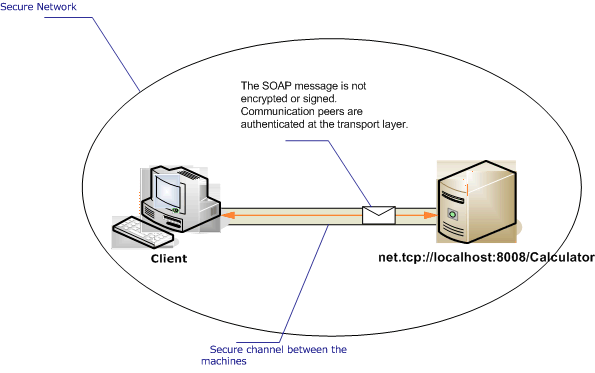Client e servizio intranet non sicuri
La figura seguente illustra un semplice servizio Windows Communication Foundation (WCF) sviluppato per fornire informazioni su una rete privata sicura a un'applicazione WCF. La sicurezza non è necessaria perché i dati sono di importanza bassa, la rete dovrebbe essere intrinsecamente sicura o la sicurezza viene fornita da un livello al di sotto dell'infrastruttura WCF.

| Caratteristica | Descrizione |
|---|---|
| Modalità di sicurezza | Nessuno |
| Trasporto | TCP |
| Vincolo | NetTcpBinding |
| Interoperabilità | Solo WCF |
| Autenticazione | Nessuno |
| Integrità | Nessuno |
| Riservatezza | Nessuno |
Servizio
Il codice e la configurazione seguenti devono essere eseguiti in modo indipendente. Esegui una delle operazioni seguenti:
Creare un servizio autonomo usando il codice senza alcuna configurazione.
Creare un servizio usando la configurazione fornita, ma non definire alcun endpoint.
Codice
Il codice seguente illustra come creare un endpoint senza sicurezza:
Uri tcpUri = new Uri("net.tcp://localhost:8008/Calculator");
// Create the ServiceHost.
ServiceHost sh = new ServiceHost(typeof(Calculator), tcpUri);
// Create a binding that uses TCP and set the security mode to none.
NetTcpBinding b = new NetTcpBinding();
b.Security.Mode = SecurityMode.None;
// Add an endpoint to the service.
sh.AddServiceEndpoint(typeof(ICalculator), b, "");
// Open the service and wait for calls.
sh.Open();
string listenUri = sh.Description.Endpoints[0].ListenUri.AbsoluteUri;
Console.WriteLine($"Listening on: {listenUri}");
Console.Write("Press Enter to end the service");
Console.ReadLine();
// Close the service when a key is pressed.
Dim tcpUri As New Uri("net.tcp://localhost:8008/Calculator")
' Create the ServiceHost.
Dim sh As New ServiceHost(GetType(Calculator), tcpUri)
' Create a binding that uses TCP and set the security mode to none.
Dim b As New NetTcpBinding()
b.Security.Mode = SecurityMode.None
' Add an endpoint to the service.
sh.AddServiceEndpoint(GetType(ICalculator), b, "")
' Open the service and wait for calls.
sh.Open()
Dim listenUri As String = sh.Description.Endpoints(0).ListenUri.AbsoluteUri
Console.WriteLine("Listening on: {0}", listenUri)
Console.Write("Press Enter to end the service")
Console.ReadLine()
' Close the service when a key is pressed.
Configurazione
Il codice seguente configura lo stesso endpoint tramite configurazione.
<?xml version="1.0" encoding="utf-8"?>
<configuration>
<system.serviceModel>
<behaviors />
<services>
<service behaviorConfiguration=""
name="ServiceModel.Calculator">
<endpoint address="net.tcp://localhost:8008/Calculator"
binding="netTcpBinding"
bindingConfiguration="tcp_Unsecured"
name="netTcp_ICalculator"
contract="ServiceModel.ICalculator" />
</service>
</services>
<bindings>
<netTcpBinding>
<binding name="tcp_Unsecured">
<security mode="None" />
</binding>
</netTcpBinding>
</bindings>
<client />
</system.serviceModel>
</configuration>
Cliente
Il codice e la configurazione seguenti devono essere eseguiti in modo indipendente. Esegui una delle operazioni seguenti:
Creare un client autonomo usando il codice (e il codice client).
Creare un client che non definisce indirizzi endpoint. Usare invece il costruttore client che accetta il nome di configurazione come argomento. Per esempio:
CalculatorClient cc = new CalculatorClient("EndpointConfigurationName");Dim cc As New CalculatorClient("EndpointConfigurationName")
Codice
Il codice seguente illustra un client WCF di base che accede a un endpoint non protetto usando il protocollo TCP.
// Create an instance of the NetTcpBinding and set the
// security mode to none.
NetTcpBinding myBinding = new NetTcpBinding();
myBinding.Security.Mode = SecurityMode.None;
// Create the address string, or get it from configuration.
string tcpUri = "net.tcp://machineName:8008/Calculator";
// Create an endpoint address with the address.
EndpointAddress myEndpointAddress = new EndpointAddress(tcpUri);
// Create an instance of the WCF client. The client
// code was generated using the Svcutil.exe tool.
CalculatorClient cc = new CalculatorClient(myBinding, myEndpointAddress);
try
{
cc.Open();
' Create an instance of the NetTcpBinding and set the
' security mode to none.
Dim myBinding As New NetTcpBinding()
myBinding.Security.Mode = SecurityMode.None
' Create the address string, or get it from configuration.
Dim tcpUri As String = "net.tcp://machineName:8008/Calculator"
' Create an endpoint address with the address.
Dim myEndpointAddress As New EndpointAddress(tcpUri)
' Create an instance of the WCF client. The client
' code was generated using the Svcutil.exe tool.
Dim cc As New CalculatorClient(myBinding, myEndpointAddress)
Try
cc.Open()
Configurazione
Il codice di configurazione seguente si applica al client:
<?xml version="1.0" encoding="utf-8"?>
<configuration>
<system.serviceModel>
<bindings>
<netTcpBinding>
<binding name="NetTcpBinding_ICalculator" >
<security mode="None">
</security>
</binding>
</netTcpBinding>
</bindings>
<client>
<endpoint address="net.tcp://machineName:8008/Calculator "
binding="netTcpBinding"
bindingConfiguration="NetTcpBinding_ICalculator"
contract="ICalculator"
name="NetTcpBinding_ICalculator" />
</client>
</system.serviceModel>
</configuration>